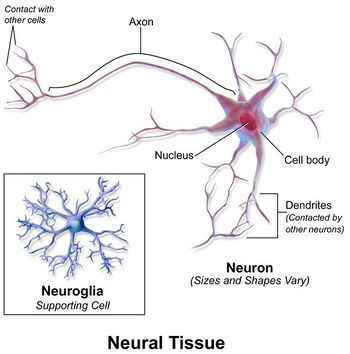Glial cell
This article is a stub. The talk page may contain suggestions. |

Glial cells, commonly called neuroglia or simply glia, are one of two major classes of cells in neural tissues, the other being neurons. Glia, which is Greek for glue, have traditionally been viewed as the glue that holds the neuronal system together, representing the historical view that glia exist to provide support to neurons. However, the type of glia known as microglia was subsequently found to actually be a tissue-resident macrophage, an immune cell. There is also increasing evidence that the type of glia known as astrocytes may play a more active role in brain function, by influencing and perhaps directing the activity of neurons (SFN 2000)."[1]
Glial activation[edit | edit source]
Glasson (2017) described the following model showing the effects of sustained glial activation.

Learn more[edit | edit source]
- 2-Minute Neuroscience: Glial Cells by Neuroscientifically Challenged via YouTube
- The Neuroinflammatory Etiopathology of Myalgic Encephalomyelitis/Chronic Fatigue Syndrome (ME/CFS)[2] (Full text)
See also[edit | edit source]
Learn more[edit | edit source]
References[edit | edit source]
- ↑ Glial cells - New World Encyclopedia
- ↑ 2.0 2.1 Glassford, Julian A.G. (2017). "The Neuroinflammatory Etiopathology of Myalgic Encephalomyelitis/Chronic Fatigue Syndrome (ME/CFS)". Frontiers in Physiology. 8. doi:10.3389/fphys.2017.00088. ISSN 1664-042X. PMC 5314655. PMID 28261110. Retrieved September 5, 2019.

